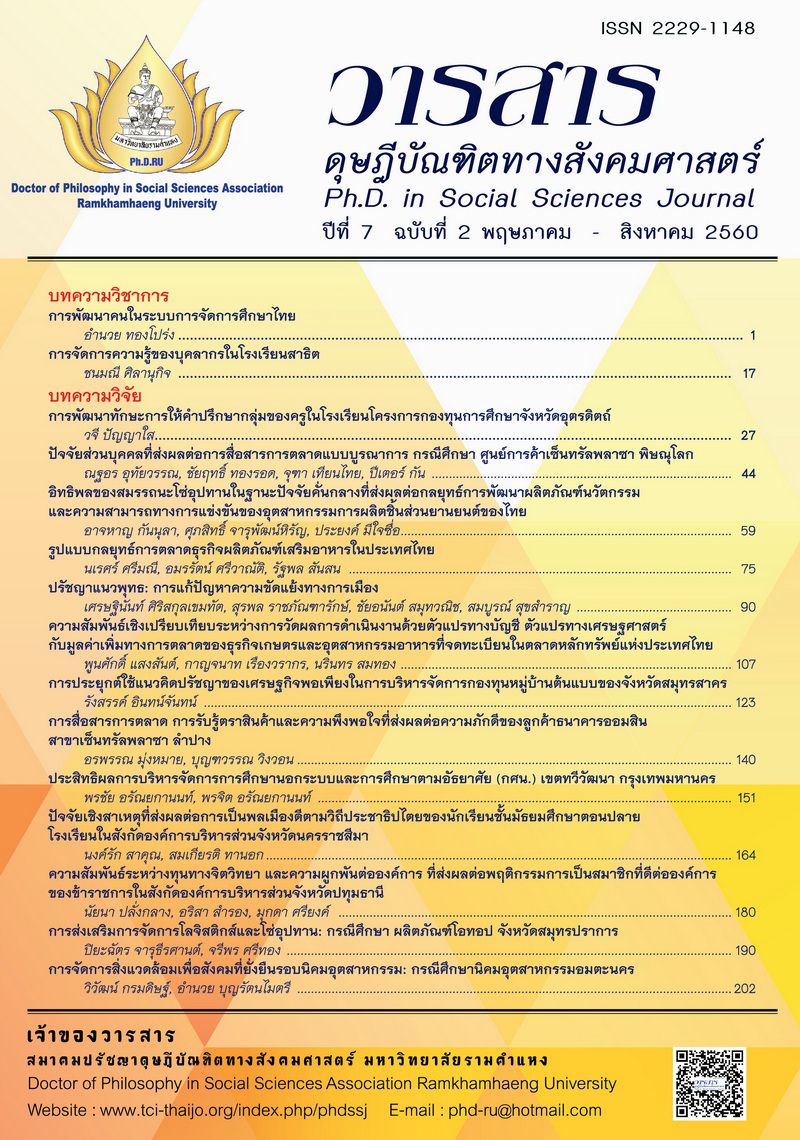ปัจจัยส่วนบุคคลที่ส่งผลต่อการสื่อสารการตลาดแบบบูรณาการ กรณีศึกษา ศูนย์การค้าเซ็นทรัลพลาซา พิษณุโลก
Main Article Content
Abstract
การวิจัยครั้งนี้ มีวัตถุประสงค์ (1) เพื่อศึกษาการรับรู้สื่อของลูกค้าที่มาใช้บริการในศูนย์การค้าเซ็นทรัลพลาซา พิษณุโลก (2) เพื่อศึกษาปัจจัยที่มีผลต่อการสื่อสารการตลาดแบบบูรณาการ กรณีศึกษาศูนย์การค้าเซ็นทรัลพลาซา พิษณุโลก และ (3) เพื่อศึกษาความเปลี่ยนแปลงของพฤติกรรมการใช้บริการในศูนย์การค้าเซ็นทรัลพลาซา พิษณุโลก โดยใช้กลุมตัวอย่างที่เป็นลูกค้าที่มาใช้บริการในศูนย์การค้าเซ็นทรัลพลาซา พิษณุโลก โดยไม่ทราบจำนวนประชากรที่แน่นอน สามารถกำหนดขนาดกลุ่มตัวอย่าง โดยใช้สูตรกำหนดขนาดตัวอย่างของ สูตร W.G.Cochran (1953) ได้จำนวนกลุ่มตัวอย่างทั้งสิ้น จำนวน 385 คน โดยใช้สถิติพรรณนาวิเคราะห์ค่าร้อยละ ค่าเฉลี่ย ส่วนเบี่ยงเบนมาตรฐาน การทดสอบค่า t-test และ One way ANOVA
ผลของการศึกษาวิจัย
1. สภาพทั่วไปของกลุ่มตัวอย่าง พบว่า กลุ่มลูกค้าที่มาใช้บริการในศูนย์การค้าเซ็นทรัลพลาซา พิษณุโลก ส่วนใหญ่ร้อยละ 60.30 เป็นเพศหญิง ร้อยละ 23.00 มีอายุระหว่าง 21-25 ปี ร้อยละ 50.00 มีระดับการศึกษาปริญญาตรี ร้อยละ 33.00 ประกอบอาชีพพนักงานบริษัทเอกชน ร้อยละ 40.30 มีรายได้ระหว่าง 10,001-15,000 บาท ร้อยละ 35.00 มีมุมมองการบริโภคเรื่องราคาสินค้า/บริการคุ้มค่าเหมาะสม ร้อยละ 57.30 มีความถี่ในการมาใช้บริการอยู่ระหว่าง 1-2 ครั้งต่อสัปดาห์ และร้อยละ 61.30 มีความคิดเกี่ยวกับการบริโภคเรื่องรูปแบบสินค้า และบริการ
2. ระดับความคิดเห็นเรื่องการสื่อสารการตลาดแบบบูรณาการ กรณีศึกษาศูนย์การค้าเซ็นทรัลพลาซา พิษณุโลก ในภาพรวมอยู่ในระดับมาก ( = 4.09)
3. ระดับความคิดเห็นเรื่องความเปลี่ยนแปลงของพฤติกรรมผู้บริโภค ในภาพรวมอยู่ในระดับมาก ( = 4.06)
PERSONAL FACTORS AFFECTING INTEGRATED MARKETING COMMUNICATIONS IN CASE STUDY CENTRAL PLAZA DEPARTMENT STORE AT PHITSANULOK
This research has objectives were (1) To study the media perception of clients used the service in Central Department store at Phitsanulok (2) To study the factors affecting integrated marketing communications in case study Central Plaza Department Store at Phitsanulok and (3) To study the changes in using service behavior at Central Plaza Department Store in Phitsanulok. This is the quantitative research that researcher used data collected from sampling group which was the clients using service in Central Plaza Department Store Phitsanulok but not knew the exactly amount of population; however, it could be specified the sample size by the specified sample size formula of W.G. Cochran (1953) and got total sampling group for 385 people furthermore using descriptive statistic, percentage analysis, average and standard deviation, t-test and One-way ANOVA
Research result
1. General status of sampling group found that clients using service in Central Plaza Department Store at Phitsanulok at 60.30 Percent was women, 23 Percent had age during 21-25-year old, 50 Percent had education at bachelor degrees, 30 Percent were private company employees, 40.30 Percent had income between 10,001 and 15,000 Baht, 35 Percent had the consume view of goods and services price whether had value of money, 57.30 Percent had the frequency of using service during 1-2 time a week and 61.30 Percent had idea about consumption model of goods and services.
2. Opinion level of integrated marking communication in case study of Central Plaza Department Store at Phitsanulok in the overview was the most level ( = 4.09) when considered in each part found that the highest average value was the advertising (
= 4.25) then special activities (
= 4.09), public relation (
= 4.07) and promotion (
= 3.97) respectively.
3. Opinion level of the changes consumer behavior, in the big picture the highest level ( = 4.06) when considered in each part found that the highest average were selecting the products (average of 4.13) then selecting brand (
= 4.04) and selecting purchasing quantity (
= 4.0)
Article Details
Academic articles, research articles, and book reviews in the Ph.D. in Social Sciences Journal are author’s opinions, and not the publisher’s, and is not the responsibility of the Ph.D. in Social Sciences Journal Philosophy Association, Ramkhamhaeng University. (In the case that research is done on human, the researcher has to be trained in Ethics for Doing Research on Human Training and has to produce the evidence of the training).


